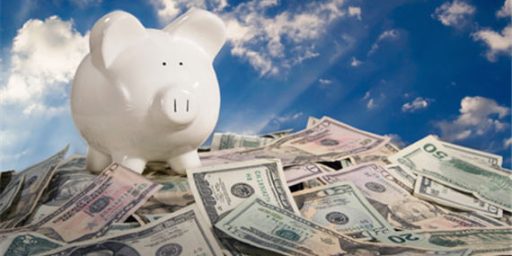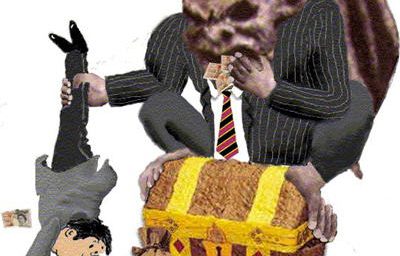Dynamic Scoring and Tax Cuts Paying for Themselves
In two previous posts I have argued that the idea that the tax reciepts are paying for themselves (in other words, are the sole reason tax revenues are increasing) is a load of baloney. Now there are a couple of working papers (one forth coming in the Journal of Public Economics) that support my position.
Before getting into the the two papers I want to point out that my position isn’t that the tax cuts haven’t had a stimulus component to them. The exact opposite is true. I think the tax cuts were one of the reasons why the last recession was so short and shallow. So if any commenters are inclined to make a strawman argument that I think that tax cuts didn’t do any good, please tatoo this paragraph on your forehead.
Typically, the effect of changes in tax rates is determined by static scoring. With static scoring all feedback effects of changes in the tax rate are ignored. If there are positive feedback effects then the cost of the tax cut (in terms of decreased revenues) is overestimated. If their are negative feedbacks, then the cost is overestimated. So the questions is what are these feedback effects like? On one extreme there is the group that says that there is no positive (or negative) feedback effects. These are the people that think that static scoring of tax changes is sufficient. At the other extreme are those who many would consider supply siders who argue, via the Laffer curve, that the tax cuts can either pay for themselves or even generate an increase in revenues.
The first paper is by N. Gregory Mankiw and Matthew Weinzierl (both at Harvard, and Mankiw was Bush’s former head of the Council of Economic Advisors). This paper looks at the dynamic impact of labor tax cuts (think income taxes here) and a cut in taxes of capital (capital gains taxes). To look at this Mankiew and Weinzierl utilize the neoclassical growth model first put forward by Ramsey in 1928.
In the most simply form of their model, Mankiw and Weinzierl note that changes in the capital tax rate is not the same as in the static case. However, the nature of the feedback depends on the parameters of the model and the tax rates. For the simple model, Mankiw and Weinzierl pick what they argue are plausible paramters/tax rates and find that in the case of a cut in the capital gains tax that the tax cuts pays for 50% tax cut.
Mankiw and Weinzierl then generaliz their simple model in a number of ways such as including elastic labor supply, a more general production technology, and so forth. One of the findings here is that a cut in the labor tax will pay for about 17% of the tax cut. Not nearly as large as many who claim the tax cuts are driving tax reciepts would probably like. Still, the conclusion here is that under the right conditions tax cuts can, at least in part, be self-financing.
The next paper (sorry no link to the paper, I had to purchase it via NBER) by Eric Leeper and Su-Chun Susan Yang looks at the results attained by Mankiw and Weinzierl and relax the assumption that “the government’s budget constraint is always satisfied”. What does that mean? It means that one of Mankiw and Weinzierl’s assumptions is that the government’s budget is always balanced. Mankiw and Weinzierl themselves note that this is likely an unrealistic assumption and that their results should be regarded as a “first step”.
Leeper and Yang find that the dynamic impact of tax cuts relative to the state impact depends on financing mechanisms as well as the model callibration. In some instances the tax cut can actually cost more in dynamic terms than the static. What does that mean in more simple terms? It means that debt financed tax cuts might actually lower growth.
These two papers represent some important steps forward in investigating the impacts of tax cuts on the economy. The idea that one can deduce the impacts simply by giving the issue a few minutes thought is false. The rhetoric often espoused by conservative commentators (both on blogs and the radio) that tax cuts always increase tax revenues is also false. Similarly, the idea, often espoused by liberal commentators, that debt financed tax cuts are always bad is also false.





Indeed. So wouldn’t Mankiw have a vested interest in “beautifying” the tax cuts he had to defend (and try to extend) while in that position? The assumption you mention later, that the gov’t’s budget is always balanced, would seem to make their entire set of conclusions laughable…
Well legion, I can only conclude this is the very first economics paper you’ve only partially read. Now try reading it, and pay special attention to the conclusion.
Steve,
wow what a liberal u r!
I did read the studies, but you know what else I study? Facts.
Look, I know it’s hard for you libs to understand FACTS. Like increased tax receipts that would NOT have been there if not for the economy that was stimulated by tax cuts. You liberals believe that the growth would have been there regardless and that by giving people back THEIR money that there is then less money for govt to work with. WRONG!
Its been proven over and over and over and over again. How many times does it take? Yes I will acknowledge that R’s in congress need to reign in spending. But the fact is that without the tax cuts LESS revenue would have been brought in. Can’t you liberals understand that?
C’MON! THINK!!!!
Christopher,
You’re wrong. Getting worked up over “supply side” economics, which is not an actual school of economic thought, is a little embarrassing.
Consider this: Mankiw’s results (I’m relying on his blog and Steve’s data points) indicate that the tax cuts do not pay for themselves. Tax cuts on wages pay for something like 17% of the lost revenue while tax cuts on capital pay for about half of the lost revenue.
As with most people, they ignore the fact that the Laffer curve, which is a fine tool for studying this, has a left side. If the criteria for judging our position on it is the ability of tax cuts to pay for themselves, we are on the left side, where increases in tax rates raise revenue.
Now, as Steve said, there are other arguments for tax cuts, including stimulus and starve the beast qualities that might reduce the size of government. Tax cuts paying for themselves ain’t one of them in our country.
Sell it in Europe; it would likely apply better there.
does anyone think tax cuts are justified by the fact that our government simply costs too much?? does anyone who pays his own way think the government we have is a bargain, provided by competent leaders??
Well not quite costs too much, more like I just don’t think it should be doing much of what it is doing.
No.
I love the implication here.
But for the tax cuts we’d be in our 5th year of a recession. The worst recession since the Great Depression in fact.
What has been proven over and over again? That tax revenues go up when the economy expands and down when they contract? I agree. That the save for the tax cuts revenues would still be going down…I don’t think so. This doesn’t even pass the giggle test.
Steve,
What caused the economy to expand, and to expand as much as it has so far? The tax cuts. If you don’t understand that, go back to the 9th grade.
I agree that the tax cuts were probably a positive factor, but the cyclic nature of the economy does not hinge solely on taxes. Every economist understands this, even guys like Arthur Laffer and Milton Friedman.
I think part of the issue is that for both the laffer curve and whether a tax cut can generate more revenue to replace it self, you can easily see the issues at the extremes, but there are enough other independent factors involved that its hard to come up with a good real world applicable model. Further, my own personal view is that the laffer curve changes with time/attitudes. Prior to FDR, the government was sub-5% of the GDP. Now we spend more than that just on the military. The 1913 income tax rates were started with a 1% rate on $3000 for an individual ($4000 for a couple). That would be equivalent to a 1% rate on $60540 for an individual or $80720 for a couple today. And they had exemptions and deductions that lowered the effective rate to below 1%. The top rate in 1913 was for 7% for amounts over $500,000 ($10,090,000 in today’s dollars). Can you realistically imagine either the right or the left willing to accept a government that could be funded by such a low rate? And yet it was a major imposition at the time.
Could a tax cut be self funding? Sure, look at the capital gains tax.
In 2001, the leftist CBPP argued against the cut in the capital gains tax from 20% to 15%. They argued that any short term tax gain would be balanced by long term tax loss. So at a minimum, they acknowledged there could be a self funding aspect (even if only short term). What actually happened was the tax collection rose from $49B in 2002 before the capital tax rate cut to $51B in 2003 when the cut first took effect to $71B in 2004 to $80B in 2005. So a 25% reduction in the rate has increased the amount collected by 45%, presumably much more than the economy has grown.
The same 5% reduction to a higher or lower rate may impact how much income is collected. The 5% equaling 25% of the total tax rate made enough of a major shift in people’s thinking to spur changes in behavior to collect more taxes. To see if income tax could have the same sort of impact, we would need to see about a 9% reduction in the top rate.
Thoretically and based on the capital gains, we can see that a change in tax rate can change behavior such that the total brought in is more than the prior rate. I think similar evidence could be shown that the income tax rates, which were more modest in both the absolute tax cut and especially as a percentage of the tax rate, have not done this so far. If you add in the questions of how soon a recession would have ended and how robust the recovery would be with out the stimulus of lower taxes (or from the left if they provide any stimulus what so ever), you can understand why this is a difficult issue to model. But catagorical statements that a tax cut can’t be seen to pay for itself also don’t seem to bear up under the facts.
Reagans quipped about economists s being people who would look at something happening in the real world and wonder if it would work in theory. I think that no one has a good model on tax cuts (including size, where directed, etc) vs tax revenue that can come even close to predicting reality. So we see partisan attempts on both sides to get the outcome we want to see based on the theory or facts, which ever are more convenient.
YAJ,
My take is precisely the opposite, the partisans don’t want to look at the models/economics because it might contradict their preferred policies.